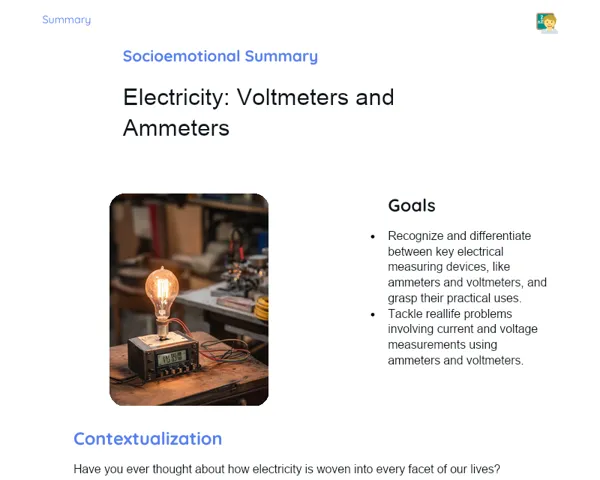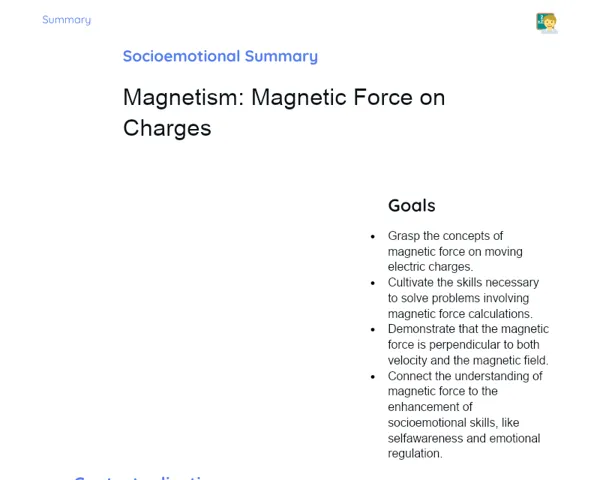Socioemotional Summary Conclusion
Goals
1. Understand and describe the wave equation using sinusoidal functions.
2. Identify and articulate the emotions linked to grappling with complex concepts in Physics.
3. Cultivate self-awareness and self-control skills while tackling mathematical problems related to waves.
Contextualization
🌊📻 Waves are everywhere! From the sound waves that bring us our favourite music to radio waves that facilitate communication. Grasping how they function through equations paves the way for groundbreaking applications in engineering, healthcare, technology, and much more. Are you aiming to create the next big innovation? Let’s dive in! 🚀📡
Exercising Your Knowledge
Introduction to Waves
A wave is a disturbance that moves through a medium, carrying energy while leaving matter in place. This means that while the wave transports energy, it doesn’t move any mass from one location to another. Waves manifest in various forms around us, like sound waves, electromagnetic waves, and water waves.
-
Disturbance: The initial cause that creates the wave, similar to tossing a stone into a pond.
-
Propagation: The travel of the wave's energy through the medium, such as the ripples on the surface of water.
-
Energy: Waves transmit energy through the medium without displacing matter.
Components of a Wave
Waves possess distinct elements that define their properties and behaviours. These elements include crest, trough, wavelength, amplitude, frequency, and period. Understanding these components is crucial to grasp how waves operate and convey energy.
-
Crest: The peak of the wave.
-
Trough: The lowest point of the wave.
-
Wavelength (λ): The distance between two adjacent crests or two adjacent troughs.
-
Amplitude (A): The height of the wave, measured from the midpoint to the crest or trough.
-
Frequency (f): The number of waves passing a point in one second.
-
Period (T): The time taken for a wave to complete one full cycle.
Wave Equation
The mathematical representation of a sinusoidal wave is a vital tool for detailing its behaviour. The equation y(x,t) = A * sin(kx - ωt + φ) enables us to pinpoint the wave's position at any moment, taking into account amplitude, wave number, angular frequency, time, and initial phase.
-
Amplitude (A): Indicates the energy carried by the wave.
-
Wave Number (k): Determined as k = 2π/λ, represents the number of wave cycles per unit length.
-
Angular Frequency (ω): Given as ω = 2πf, indicates how many cycles occur over a unit of time.
-
Time (t): The variable that denotes the moment at which the wave's position is evaluated.
-
Initial Phase (φ): The wave's starting point along its cycle, influencing its temporal position.
Key Terms
-
Waves: Disturbances that transfer energy without moving matter.
-
Wave Equation: Mathematical expression that characterises the behaviour of a wave.
-
Sinusoidal Functions: Functions used to depict periodic waves mathematically.
-
Amplitude: The height of the wave from its midpoint.
-
Wavelength (λ): The distance between two consecutive equivalent points on the wave.
-
Frequency (f): The count of wave cycles at a point each second.
-
Period (T): The time needed to complete one wave cycle.
-
Wave Number (k): The count of wave cycles per unit distance.
-
Angular Frequency (ω): The count of wave cycles per unit time.
-
Initial Phase (φ): The wave's starting position within its cycle.
For Reflection
-
How do you feel when confronted with challenging problems like the wave equation? What emotions surface and how do you manage them?
-
Can you recount a time in class when you found something particularly tough? What was your initial emotional response and how did you navigate through it?
-
Reflect on the significance of acknowledging and articulating your emotions during learning. How might this enhance your academic and personal achievements?
Important Conclusions
-
🌊 Understanding waves and their equations is crucial for grasping how energy moves through various media.
-
📈 The sinusoidal wave equation equips us with the tools to mathematically portray wave behaviour, which is essential in countless technological advancements.
-
🔍 Delving into waves encompasses not just technical know-how but also socio-emotional skills, like recognising and managing emotions in the face of complex challenges.
Impacts on Society
Waves weave their way through every aspect of our daily lives. For example, the communication technologies we depend on, like smartphones and the internet, rely heavily on electromagnetic waves. In addition, healthcare employs ultrasonic waves in imaging methods like ultrasounds, which are critical for diagnoses and health check-ups. 📱🩺
On a personal level, understanding the mechanics of waves can transform our connection with the world. Realising that sound waves make our cherished music possible or that radio waves bring our favourite shows to us fosters a deeper emotional bond with what we learn. 🎶📻
Dealing with Emotions
To better manage your emotions while studying the wave equation, consider employing the RULER method at home: Start by recognising your emotions when you hit a challenging problem; it could be frustration, anxiety, or curiosity. Next, understand the reasons behind these feelings. You might be frustrated because a problem isn't coming to you easily. Name those emotions explicitly - 'I am feeling frustrated.' Then, express them appropriately, whether it’s chatting with a friend or jotting it down in a diary. Finally, regulate your emotions by practising some breathing exercises or taking a brief pause to refresh your mind. 🧘♂️🧘♀️
Study Tips
-
📚 Regular Revision: At the close of the day, revisit the concepts of waves and their equations to reinforce your understanding.
-
📝 Use Visual Aids: Diagrams and charts aid in comprehending wave behaviours better. Sketch the waves and label their segments.
-
🤝 Engage in Study Groups: Collaborating with peers can clarify doubts and promote diverse approaches and strategies for problem-solving.



